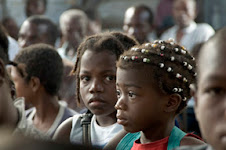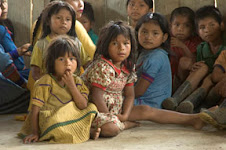
I have mentioned that downtown Quibdó is an intense, even frenetic focus of commercial activity. (Keep in mind that Quibdó is a sprawling city—in the barrios, the activity is much reduced. Although the main streets there are filled with active, noisy traffic and some little stores and workshops—and they’re paved—the side streets where people live are peaceful, relatively quiet—and unpaved. And the new barrios in the Northern Zone, where many displaced people live, don’t even have main streets.) I know the center best, as Barrio Esmeralda, where the Casa de Encuentros is, is relatively close in, and the center is where most organizations and institutions have their offices.
If you go downtown a little earlier than the rush hour—get to the center at 7 or 7:30 AM, you’ll find groups of men at the key corners of the Alameda hanging around, presumably hoping for work unloading trucks or other employment in the informal economy. This is called the “rebusque” here—the intense search for work—and it’s the main way the majority of people eke out an income.
I’ll have a lot more to share about Quibdó, and especially the downtown, which
 despite it’s craziness I find very attractive. But for now, I want to look at a particular question.
despite it’s craziness I find very attractive. But for now, I want to look at a particular question.Until now, the main question for me has been, How do people in this town afford all the stuff that’s for sale? Especially electrical appliances, or in the hardware stores, which are really good, or the pharmacies, which have no beach balls or pretzels, but good, modern drugs, toothbrushes, beauty stuff—for those who can afford it! (And make no mistake, despite the absence of major businesses, there some rich people here.)
But recently, friends here have pointed to another way to interpret what’s going on here. Pointing especially to imported fresh fruits and vegetables, they argue that things are not too expensive, but too cheap!
In the little vegetable shops, you can find apples, pears, kiwis and grapes from Chile. This means that they have been shipped, probably arriving in the port of Buenaventura. From there they go by truck to Pereira or Medellín, and from there to Quibdó, and here they are distributed to the retail outlets. But despite all this in the shops, I bought a couple if kiwi the other day for 1000 pesos (about .50 USD) each. (Probably not so good to convert to dollars, since the dollar seems to be falling against the peso every day.) That’s pretty cheap, really. I think the apples would be about the same price, perhaps a little cheaper. But in the carts in the street, the apples range from 1000 pesos each to 500 peso for three! How can they be covering their costs?
This, my friends tell me, is because a great deal of this commerce is nothing but a façade. What’s really going on here is money laundering. I’m told that the southern part of Chocó is now thick with coca plantings, controlled by paramilitaries and “ex”-paramilitaries. They say that in the southern city of Istmina, smaller than Quibdó, there’s even more wealth on display. It’s certainly well known that some high-level politicians here have been implicated in the drug trade. And with the broadly acknowledged extensive corruption of public officials here, it all fits together pretty well.
So this suggests that at least one of the motors that drives the exuberant commercial economy of Quibdó is the drug trade. Of course, no one will be talking about this on the street. To me it makes a lot of sense, though I haven’t tried to do a first-hand investigation. And I have no plans to do so…
He mencionado que el centro de Quibdó es un enfoque intenso, hasta frenético de actividad comercial. (Tengan presente que Quibdó es una ciudad de extensión grande—en los barrios, la actividad es mucho menos. Aunque las calles principales allá son lleno de tráfico activo y bullicioso, con unas tiendas pequeñas y talleres—y son pavimentadas—las calles laterales donde vive la gente son tranquilas, relativamente silenciosas—y sin pavimentar. Y los barrios nuevos de la Zona Norte, donde vive mucha gente desplazada, ni siquiera tienen calles principales. Conozco mejor el centro, ya que Barrio Esmeralda, donde queda la Casa de Encuentros, está relativamente cerca, y la mayoría de las organizaciones e instituciones tienen sus oficinas en el centro.

Si vas al centro un poco antes de la hora pico—si llegas a las 7 o 7:30 AM, encontrarás grupos de hombres en las equinas claves de la Alameda, esperando, esperando, se presume que están en la espera de conseguir una chambita descargando carros u otra tarea en la economía informal. Acá esto se llama el “rebusque” y es la principal manera en que la mayoría de la gente gane un poquito de dinero.
Tendré mucho más que compartir sobre Quibdo, y especialmente el centro, el cual, a pesar de su locura, para mi tiene su atractivo. Pero ahora quiero considerar un tema en especial.
Hasta ahora, la pregunta principal mía ha sido ¿Cómo puede aguantar el costo de todas las cosas que están la vente la gente de esta ciudad? Sobre todo electrodomésticos, o en las ferreterías, que de hecho son muy buenas, o las farmacias (“droguerías” acá), que no vended toda clase de juguetes y golosinas como en casa, más sin embargo tienen buenos, modernos medicamentos, cepillas de dientes, cosas de la belleza—¡para quienes tengan el dinero! (Y no te vayas a equivocar, a pesar de la falta de grandes negocios, acá hay ricos.)
Pero últimamente, amig@s acá me han indicado otra manera de interpretar lo que sucede acá/ Señalado sobre todo frutas y legumbres frescos importado, argumentan que las cosas no son demasiado caras, sino ¡exageradamente baratas!
In las legumbrerías pequeñas puedes encontrar manzanas, peras, kiwis y uvas de Chile. Quiere decir can llegaron en buque probablemente al puerto de Buenaventura, y desde allí fueron en camiones hasta Pereira o Medellín, y desde allá a Quibdó, y acá son repartidas a los minoristas. Pero a pesar de todo esto, compre un par de kiwis el otro día por 1000 pesos (alrededor de .50USD) cada una. (Probablemente no vale convertir en dólares, ya que parece que el dólar está bajando cada día contra el peso.) De hecho, es bastante barato. Creo que las manzanas salen al mismo precio, quizá un poco menos. Pero en las carretas en la calle, ¡las manzanas se venden entre 1000 pesos cada una y 500 por tres! ¿Cómo van a cubrir sus gastos?
Esto, me dicen mis amig@s, es porque mucho de este comercio no es nada más que una fachada. Lo que sucede acá es lavado de dinero. Me cuentan que la parte sureña del Chocó está y llena de plantaciones de coca, controladas por paramilitares y “ex”-paramilitares. Dicen que en la ciudad sureña de Istmina, más pequeña que Quibdo, hay aún meas riqueza a la vista. De hecho, es muy conocido que hasta unos políticos de alto nivel acá han sido implicados en el narcotráfico. Y con la corrupción extensiva y ampliamente reconocida de oficiales públicos aquí, todo tiene sentido.

Entonces, todo eso sugiere que por lo menos uno de los motores que conducen el comercio exuberante de Quibdo es el narcotráfico. Desde luego, en la calle no se habla de esto. A mi me parece muy razonable, aunque no he realizado una investigación personal. Y no pretendo hacerlo…


2 comments:
Steve
i love your description of the local economy and especially the photographs which are warm, generous and human scale(as usual).
be well
don
Thanks for writing this.
Post a Comment